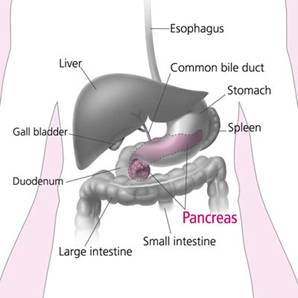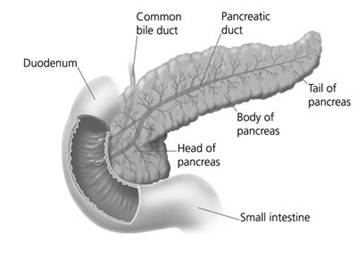Pancreatic Cancer
Introduction:
This National page has important information about cancer* of the pancreas. In the United States, cancer of the pancreas is diagnosed in more than 29,000 people every year.
This booklet discusses possible causes of cancer of the pancreas. It also describes symptoms, diagnosis, treatment, and follow-up care. This information can help patients and their families better understand and cope with this disease.
Scientists are studying cancer of the pancreas to learn more about this disease. They are finding out more about its causes. Doctors are exploring new ways to treat it. Research already has led to better quality of life for people with cancer of the pancreas.
The Pancreas
 The pancreas is a gland located deep in the abdomen between the stomach and the spine (backbone). The liver, intestine, and other organs surround the pancreas.
The pancreas is a gland located deep in the abdomen between the stomach and the spine (backbone). The liver, intestine, and other organs surround the pancreas.
The pancreas is about 6 inches long and is shaped like a flat pear. The widest part of the pancreas is the head, the middle section is the body, and the thinnest part is the tail.
The pancreas makes insulin and other hormones. These hormones enter the bloodstream and travel throughout the body. They help the body use or store the energy that comes from food. For example, insulin helps control the amount of sugar in the blood.
The pancreas also makes pancreatic juices. These juices contain enzymes that help digest food. The pancreas releases the juices into a system of ducts leading to the common bile duct. The common bile duct empties into the duodenum, the first section of the small intestine.
Understanding Cancer
 Cancer is a group of many related diseases. All cancers begin in cells, the body's basic unit of life. Cells make up tissues, and tissues make up the organs of the body.
Cancer is a group of many related diseases. All cancers begin in cells, the body's basic unit of life. Cells make up tissues, and tissues make up the organs of the body.
Normally, cells grow and divide to form new cells as the body needs them. When cells grow old and die, new cells take their place.
Sometimes this orderly process breaks down. New cells form when the body does not need them, or old cells do not die when they should. These extra cells can form a mass of tissue called a growth or tumor.
Tumors can be benign or malignant:
- Benign tumors are not cancer. Usually, doctors can remove them. In most cases, benign tumors do not come back after they are removed. Cells from benign tumors do not spread to tissues around them or to other parts of the body. Most important, benign tumors are rarely a threat to life.
- Malignant tumors are cancer. They are generally more serious and may be life threatening. Cancer cells can invade and damage nearby tissues and organs. Also, cancer cells can break away from a malignant tumor and enter the bloodstream or lymphatic system. That is how cancer cells spread from the original cancer (primary tumor) to form new tumors in other organs. The spread of cancer is called metastasis.
Most pancreatic cancers begin in the ducts that carry pancreatic juices. Cancer of the pancreas may be called pancreatic cancer or carcinoma of the pancreas.
A rare type of pancreatic cancer begins in the cells that make insulin and other hormones. Cancer that begins in these cells is called islet cell cancer.
When cancer of the pancreas spreads (metastasizes) outside the pancreas, cancer cells are often found in nearby lymph nodes. If the cancer has reached these nodes, it means that cancer cells may have spread to other lymph nodes or other tissues, such as the liver or lungs. Sometimes cancer of the pancreas spreads to the peritoneum, the tissue that lines the abdomen.
When cancer spreads from its original place to another part of the body, the new tumor has the same kind of abnormal cells and the same name as the primary tumor. For example, if cancer of the pancreas spreads to the liver, the cancer cells in the liver are pancreatic cancer cells. The disease is metastatic pancreatic cancer, not liver cancer. It is treated as pancreatic cancer, not liver cancer
Pancreatic Cancer: Who's at Risk?
No one knows the exact causes of pancreatic cancer. Doctors can seldom explain why one person gets pancreatic cancer and another does not. However, it is clear that this disease is not contagious. No one can "catch" cancer from another person.
Research has shown that people with certain risk factors are more likely than others to develop pancreatic cancer. A risk factor is anything that increases a person's chance of developing a disease.
Studies have found the following risk factors:
- Age -- The likelihood of developing pancreatic cancer increases with age. Most pancreatic cancers occur in people over the age of 60.
- Smoking -- Cigarette smokers are two or three times more likely than nonsmokers to develop pancreatic cancer.
- Diabetes -- Pancreatic cancer occurs more often in people who have diabetes than in people who do not.
- Being male -- More men than women are diagnosed with pancreatic cancer.
- Being African American -- African Americans are more likely than Asians, Hispanics, or whites to get pancreatic cancer.
- Family history -- The risk for developing pancreatic cancer triples if a person's mother, father, sister, or brother had the disease. Also, a family history of colon or ovarian cancer increases the risk of pancreatic cancer.
- Chronic pancreatitis -- Chronic pancreatitis is a painful condition of the pancreas. Some evidence suggests that chronic pancreatitis may increase the risk of pancreatic cancer.
Other studies suggest that exposure to certain chemicals in the workplace or a diet high in fat may increase the chance of getting pancreatic cancer.
Most people with known risk factors do not get pancreatic cancer. On the other hand, many who do get the disease have none of these factors. People who think they may be at risk for pancreatic cancer should discuss this concern with their doctor. The doctor may suggest ways to reduce the risk and can plan an appropriate schedule for checkups.
Symptoms
Pancreatic cancer is sometimes called a "silent disease" because early pancreatic cancer often does not cause symptoms. But, as the cancer grows, symptoms may include:
- Pain in the upper abdomen or upper back
- Yellow skin and eyes, and dark urine from jaundice
- Weakness
- Loss of appetite
- Nausea and vomiting
- Weight loss
These symptoms are not sure signs of pancreatic cancer. An infection or other problem could also cause these symptoms. Only a doctor can diagnose the cause of a person's symptoms. Anyone with these symptoms should see a doctor so that the doctor can treat any problem as early as possible





































